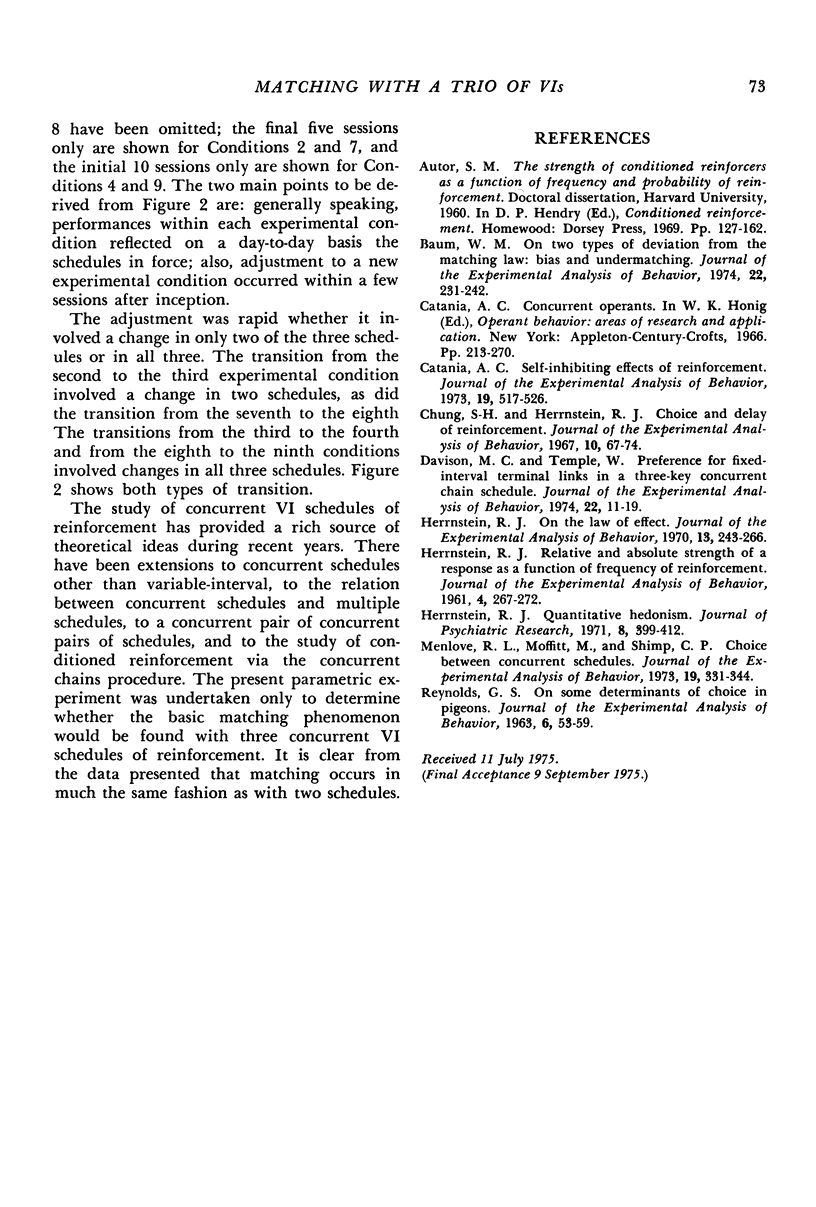Abstract
A trio of concurrent variable-interval schedules of reinforcement was arranged according to a changeover-key procedure, including a changeover delay of 1.5 sec. The three schedules provided a combined maximum reinforcement rate of 45 reinforcements per hour. With that restriction, the nine experimental conditions included several combinations of variable-interval schedules, sometimes including extinction. The pigeons matched relative response rate and relative time to relative reinforcement rate. Relative time appeared to match some-what better than relative response rate. Performance adjusted rapidly from one experimental condition to the next, whether the change involved two or all three schedules of the concurrent trio.
Keywords: concurrent schedules, matching, variable interval, pigeons
Full text
PDF




Selected References
These references are in PubMed. This may not be the complete list of references from this article.
- Baum W. M. On two types of deviation from the matching law: bias and undermatching. J Exp Anal Behav. 1974 Jul;22(1):231–242. doi: 10.1901/jeab.1974.22-231. [DOI] [PMC free article] [PubMed] [Google Scholar]
- Catania A. C. Self-inhibiting effects of reinforcement. J Exp Anal Behav. 1973 May;19(3):517–526. doi: 10.1901/jeab.1973.19-517. [DOI] [PMC free article] [PubMed] [Google Scholar]
- Chung S. H., Herrnstein R. J. Choice and delay of reinforcement. J Exp Anal Behav. 1967 Jan;10(1):67–74. doi: 10.1901/jeab.1967.10-67. [DOI] [PMC free article] [PubMed] [Google Scholar]
- Davison M. C., Temple W. Preference for fixed-interval terminal links in a three-key concurrent chain schedule. J Exp Anal Behav. 1974 Jul;22(1):11–19. doi: 10.1901/jeab.1974.22-11. [DOI] [PMC free article] [PubMed] [Google Scholar]
- HERRNSTEIN R. J. Relative and absolute strength of response as a function of frequency of reinforcement. J Exp Anal Behav. 1961 Jul;4:267–272. doi: 10.1901/jeab.1961.4-267. [DOI] [PMC free article] [PubMed] [Google Scholar]
- Herrnstein R. J. On the law of effect. J Exp Anal Behav. 1970 Mar;13(2):243–266. doi: 10.1901/jeab.1970.13-243. [DOI] [PMC free article] [PubMed] [Google Scholar]
- Herrnstein R. J. Quantitative hedonism. J Psychiatr Res. 1971 Aug;8(3):399–412. doi: 10.1016/0022-3956(71)90033-1. [DOI] [PubMed] [Google Scholar]
- Menlove R. L., Moffitt M., Shimp C. P. Choice between concurrent schedules. J Exp Anal Behav. 1973 Mar;19(2):331–344. doi: 10.1901/jeab.1973.19-331. [DOI] [PMC free article] [PubMed] [Google Scholar]
- REYNOLDS G. S. On some determinants of choice in pigeons. J Exp Anal Behav. 1963 Jan;6:53–59. doi: 10.1901/jeab.1963.6-53. [DOI] [PMC free article] [PubMed] [Google Scholar]


